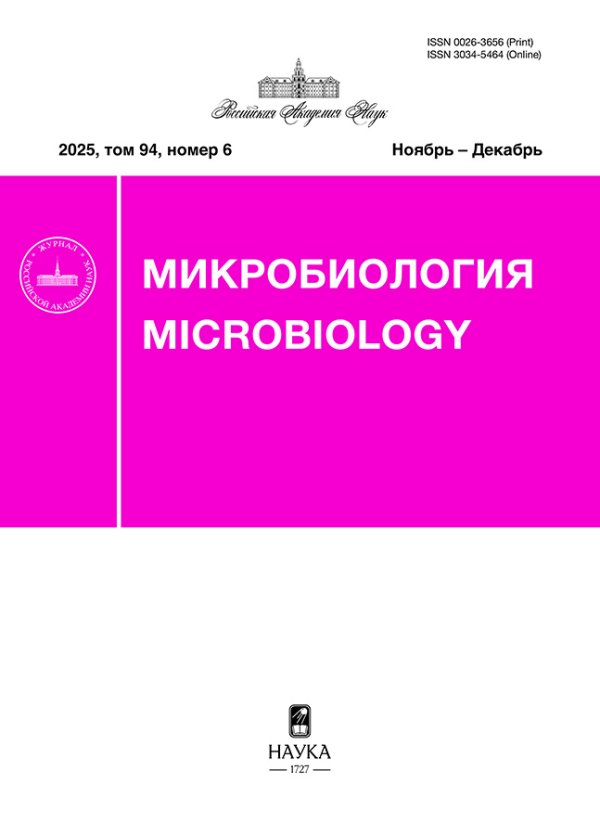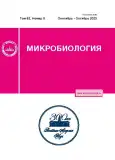Methane Production in a Temperate Freshwater Lake during an Intense Cyanobacterial Bloom
- Authors: Kallistova A.Y.1, Kosyakova A.I.1, Rusanov I.I.1, Kadnikov V.V.1, Beletskii A.V.1, Koval’ .D.1, Yusupov S.K.1, Zekker I.2, Pimenov N.V.1
-
Affiliations:
- Federal Research Center of Biotechnology, Russian Academy of Sciences
- University of Tartu
- Issue: Vol 92, No 5 (2023)
- Pages: 477-489
- Section: EXPERIMENTAL ARTICLES
- URL: https://journals.rcsi.science/0026-3656/article/view/140508
- DOI: https://doi.org/10.31857/S0026365623600256
- EDN: https://elibrary.ru/KAVSYX
- ID: 140508
Cite item
Full Text
Abstract
Abstract—
Seasonal cyanobacterial blooms have a negative impact on freshwater ecosystems. The role of cyanobacteria in methane production and their relationship with methanogenic archaea are not yet well understood. The goal of the present work was to identify the features of methanogenesis in the water column and sediments of a profoundal part of the freshwater Lake Senezh (Moscow oblast) during a period of cyanobacteria over-bloom. Analytical, radiotracer, microscopic, molecular biological, and incubation techniques were used. Alkalization and oxygen oversaturation of the 0–2-m water layer were caused by intensive photosynthesis. The near-bottom water (4 m) was pH-neutral and hypoxic; the sediments were reduced. Methane was detected throughout the water column; its concentration in the surface water was an order of magnitude lower than in the near-bottom water and 4 orders of magnitude lower than in the sediments. Cyanobacteria of the species Microcystis aeruginosa predominated in the photic zone (up to 30% of the total number of the 16S rRNA gene fragments). The sequences of cyanobacteria and freshwater members of the SAR11 clade, which can potentially be involved in aerobic methanogenesis via decomposition of methylphosphonates (MPn), were also detected. The sequences of hydrogenotrophic methanogens of the genus Methanoregula, which are potentially capable of methanogenesis in cooperation with cyanobacteria, were revealed in oxygen-supersaturated water. Hydrogenotrophic and aceticlastic pathways of methanogenesis predominated in reduced sediments. Sequences of methanogens of to the orders Methanomicrobiales, Methanobacteriales, Methanosarciniales, and Methanomassiliicoccales were detected there. Cyanobacterial bloom promoted methanogenesis both in the photic zone of Lake Senezh (due to MPn decomposition and anaerobic methanogenesis in association with cyanobacterial aggregates) and in the near-bottom water and sediments (due to oxygen depletion and excessive release of substrates caused by sedimentation and degradation of cyanobacterial mortmass).
About the authors
A. Yu. Kallistova
Federal Research Center of Biotechnology, Russian Academy of Sciences
Author for correspondence.
Email: kallistoanna@mail.ru
Russia, 119071, Moscow
A. I. Kosyakova
Federal Research Center of Biotechnology, Russian Academy of Sciences
Email: kallistoanna@mail.ru
Russia, 119071, Moscow
I. I. Rusanov
Federal Research Center of Biotechnology, Russian Academy of Sciences
Email: kallistoanna@mail.ru
Russia, 119071, Moscow
V. V. Kadnikov
Federal Research Center of Biotechnology, Russian Academy of Sciences
Email: kallistoanna@mail.ru
Russia, 119071, Moscow
A. V. Beletskii
Federal Research Center of Biotechnology, Russian Academy of Sciences
Email: kallistoanna@mail.ru
Russia, 119071, Moscow
D. D. Koval’
Federal Research Center of Biotechnology, Russian Academy of Sciences
Email: kallistoanna@mail.ru
Russia, 119071, Moscow
S. K. Yusupov
Federal Research Center of Biotechnology, Russian Academy of Sciences
Email: kallistoanna@mail.ru
Russia, 119071, Moscow
I. Zekker
University of Tartu
Email: kallistoanna@mail.ru
Estonia, 50411, Tartu
N. V. Pimenov
Federal Research Center of Biotechnology, Russian Academy of Sciences
Email: kallistoanna@mail.ru
Russia, 119071, Moscow
References
- Каллистова А.Ю., Кадников В.В., Саввичев А.С., Русанов И.И., Дворников Ю.А., Лейбман М.О., Хомутов А.В., Равин Н.В., Пименов Н.В. Сравнительное исследование путей метаногенеза в осадках термокарстовых и полигенетических ямальских озер // Микробиология. 2021. Т. 90. С. 236‒242.
- Kallistova A.Yu., Kadnikov V.V., Savvichev A.S., Rusanov I.I., Dvornikov Yu.A., Leibman M.O., Khomutov A.V., Ravin N.V., Pimenov N.V. Comparative study of methanogenic pathways in the sediments of thermokarst and polygenetic Yamal lakes // Microbiology (Moscow). 2021. V. 90. P. 261–267.
- Намсараев З.Б. Использование коэффициентов поглощения для расчета концентрации хлорофиллов и бактериохлорофиллов // Микробиология. 2009. Т. 78. С. 836‒839.
- Namsaraev Z.B. Application of extinction coefficients for quantification of chlorophylls and bacteriochlorophylls // Microbiology (Moscow). 2009. V. 78. P. 794–797.
- Самылина О.С., Меркель А.Ю., Пименов Н.В. Суточная динамика метана в цианобактериальном сообществе содового озера Горчина 1 (Кулундинская степь, Алтайский край) // Микробиология. 2023. Т. 92. С. 233–239.
- Samylina O.S., Merkel A.Y., Pimenov N.V. Diurnal methane dynamics in the cyanobacterial community of soda Lake Bitter 1 (Kulunda Steppe, Altai Krai) // Microbiology (Moscow). 2023. V. 92. P. 293–299.
- Asada Y., Kawamura S. Hydrogen evolution by Microcystis aeruginosa in darkness // Agric. Biol. Chem. 1984. V. 48. P. 2595‒2596.
- Asada Y., Miyake M., Koike Y., Aoyama K., Uemura I., Miyake J. Hydrogenase-mediated hydrogen metabolism in a non-nitrogen-fixing cyanobacterium, Microcystis aeruginosa // BioHydrogen / Eds. Zaborsky O.R., Benemann J.R., Matsunaga T., Miyake J., San Pietro A. Boston: Springer, 1998. P. 173‒179. https://doi.org/10.1007/978-0-585-35132-2_23
- Berg A., Lindblad P., Svensson B.H. Cyanobacteria as a source of hydrogen for methane formation // World J. Microbiol. Biotechnol. 2014. V. 30. P. 539‒545.
- Bižic M., Grossart H.-P., Ionescu D. Methane Paradox // eLS / Chichester: John Wiley & Sons, Ltd., 2020. P. 1‒11. https://doi.org/10.1002/9780470015902.a0028892
- Borrel G., Jézéquel D., Biderre-Petit C., Morel-Desrosiers N., Morel J.P., Peyret P., Fonty G., Lehours A.C. Production and consumption of methane in freshwater lake ecosystems // Res. Microbiol. 2011. V. 162. P. 832−847.
- Carini P., White A.E., Campbell E.O., Giovannoni S.J. Methane production by phosphate-starved SAR11 chemoheterotrophic marine bacteria // Nat. Commun. 2014. V. 5. Art. 4346. https://doi.org/10.1038/ncomms5346
- Diaz R.J., Rosenberg R. Spreading dead zones and consequences for marine ecosystems // Science. 2008. V. 321. P. 926−929.
- Edgar R.C. Search and clustering orders of magnitude faster than BLAST // Bioinformatics. 2010. V. 26. P. 2460‒2461.
- Frey B., Rime T., Phillips M., Stierli B., Hajdas I., Widmer F., Hartmann M. Microbial diversity in European alpine permafrost and active layers // FEMS Microbiol. Ecol. 2016. V. 92. Art. fiw018. https://doi.org/10.1093/femsec/fiw018
- Henson M.W., Lanclos V.C., Faircloth B.C., Thrash J.C. Cultivation and genomics of the first freshwater SAR11 (LD12) isolate // ISME J. 2018. V. 12. P. 1846‒1860.
- Huisman J., Codd G.A., Paerl H.W., Ibelings B.W., Verspagen J.M.H., Visser P.M. Cyanobacterial blooms // Nat. Rev. Microbiol. 2018. V. 16. P. 471–483.
- Kallistova A., Kadnikov V., Rusanov I., Kokryatskaya N., Beletsky A., Mardanov A., Savvichev A., Ravin N., Pimenov N. Microbial communities involved in aerobic and anaerobic methane cycling in a meromictic ferruginous subarctic lake // Aquat. Microbial Ecol. 2018. V. 82. P. 1‒18.
- Kallistova A.Yu., Koval D.D., Kadnikov V.V., Toshchakov S.V., Yusupov S.K., Izotova A.O., Vinogradova E.N., Zekker I., Pimenov N.V. Methane cycle in a littoral site of a temperate freshwater lake // Microbiology (Moscow). 2023. V. 92. P. 153–170.
- Li C., Hambright K.D., Bowen H.G., Trammell M.A., Grossart H.P., Burford M.A., Hamilton D.P., Jiang H., Latour D., Meyer E.I., Padisák J., Zamor R.M., Krumholz L.R. Global co-occurrence of methanogenic archaea and methanotrophic bacteria in Microcystis aggregates // Environ. Microbiol. 2021. V. 23. P. 6503‒6519.
- Lyautey E., Billard E., Tissot N., Jacquet S., Domaizon I. Seasonal dynamics of abundance, structure, and diversity of methanogens and methanotrophs in lake sediments // Microb. Ecol. 2021. V. 82. P. 559−571.
- Lyu Z., Lu Y. Metabolic shift at the class level sheds light on adaptation of methanogens to oxidative environments // ISME J. 2018. V. 12. P. 411−423.
- Magoč T., Salzberg S.L. FLASH: fast length adjustment of short reads to improve genome assemblies // Bioinformatics. 2011. V. 27. P. 2957‒2963.
- McAuliffe C.C. GC determination of solutes by multiple phase equilibration // Chem. Technol. 1971. V. 1. P. 46−51.
- Peura S., Sinclair L., Bertilsson S., Eiler A. Metagenomic insights into strategies of aerobic and anaerobic carbon and nitrogen transformation in boreal lakes // Sci. Rep. 2015. V. 5. Art. 12102. https://doi.org/10.1038/srep12102
- Rashid N., Song W., Park J., Jin H.-F., Lee K. Characteristics of hydrogen production by immobilized cyanobacterium Microcystis aeruginosa through cycles of photosynthesis and anaerobic incubation // Ind. Eng. Chem. 2009. V. 15. P. 498‒503.
- Reinl K.L., Harris T.D., North R.L., Almela P., Berger S.A., Bizic M., Burnet S.H., Grossart H.-P., Ibelings B.W., J-akobsson E., Knoll L.B., Lafrancois B.M., McElarney Y., Morales-Williams A.M., Obertegger U., Ogashawara I., Paule-Mercado M.C., Peierls B.L., Rusak J.A., Sarkar S., Sharma S., Trout-Haney J.V., Urrutia-Cordero P., Venkiteswaran J.J., Wain D.J., Warner K., Weyhenmeyer G.A., Yokota K. Blooms also like it cold // Limnol. Oceanogr. Lett. 2023. https://doi.org/10.1002/lol2.10316
- Rissanen A.J., Karvinen A., Nykänen H., Peura S., Tiirola M., Mäki A., Kankaala P. Effects of alternative electron acceptors on the activity and community structure of methane-producing and consuming microbes in the sediments of two shallow boreal lakes // FEMS Microbiol. Ecol. 2017. V. 93. Art. fix078. https://doi.org/10.1093/femsec/fix078
- Rognes T., Flouri T., Nichols B., Quince C., Mahé F. VSEARCH: a versatile open source tool for metagenomics // PeerJ. 2016. V. 4. Art. e2584. https://doi.org/10.7717/peerj.2584
- Smucker N.J., Beaulieu J.J., Nietch C.T., Young J.L. Increasingly severe cyanobacterial blooms and deep water hypoxia coincide with warming water temperatures in reservoirs // Glob. Change Biol. 2021. V. 27. P. 2507‒2519.
- Sorokin Y.I., Kadota H. Techniques for the assessment of microbial production and decomposition in fresh waters // IBP Handbook 23 / Oxford and London: Blackwell Scientific Publ., 1972. 112 p.
- Stal L.J. Nitrogen fixation in cyanobacteria // eLS / Chichester: John Wiley & Sons, Ltd., 2015. P. 1‒9. https://doi.org/10.1002/9780470015902.a0021159.pub2
- Tsementzi D., Rodriguez-R L.M., Ruiz-Perez C.A., Meziti A., Hatt J.K., Konstantinidis K.T. Ecogenomic characterization of widespread, closely-related SAR11 clades of the freshwater genus “Candidatus Fonsibacter” and proposal of Ca. Fonsibacter lacus sp. nov. // Syst. Appl. Microbiol. 2019. V. 42. P. 495‒505.
- Wetzel R.G. Limnology: Lake and River Ecosystems // Academic Press, 2001, 3rd edn. https://doi.org/10.1016/C2009-0-02112-6
- Wilhelm S.W., Bullerjahn G.S., McKay R.M.L. The complicated and confusing ecology of Microcystis blooms // mBio. 2020. V. 11. Art. e00529-20. https://doi.org/10.1128/mBio.00529-20
- Xu H., Liu Y., Tang Z., Li H., Li G., He Q. Methane production in harmful algal blooms collapsed water: The contribution of non-toxic Microcystis aeruginosa outweighs that of the toxic variety // J. Cleaner Product. 2020. V. 276. Art. 124280. https://doi.org/10.1016/j.jclepro.2020.124280
- Zhao L., Lin L.Z., Chen M.Y., Teng W.K., Zheng L.L., Peng L., Lv J., Brand J.J., Hu C.X., Han B.P., Song L.R., Shu W.S. The widespread capability of methylphosphonate utilization in filamentous cyanobacteria and its ecological significance // Water Res. 2022. V. 217. Art. 118385. https://doi.org/10.1016/j.watres.2022.118385
- Zhu Y., Chen X., Yang Y., Xie S. Impacts of cyanobacterial biomass and nitrate nitrogen on methanogens in eutrophic lakes // Sci. Total. Environ. 2022. V. 848. Art. 157570. https://doi.org/10.1016/j.scitotenv.2022.157570
Supplementary files














